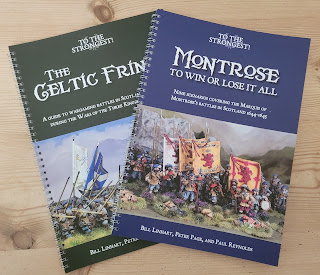Assault Parties (again)
Way back in the midst of time I posted some converted figures which would be used as assault parties - some harquebusiers on foot (converted from foot officers) and some figures from the storming party pack from PP. At the time of writing I mentioned that I had some unaltered figures from the storming party somewhere. Well they are back, and they are no longer unadulterated.
The storming party pack contains 3 petard teams and two grenado throwers.
But what is a petard, and what is a grenado?
A petard was a small explosive device attached to doors and gateways which hopefully blew the door/gate up thereby allowing the attackers to breach defences. Fun fact: petard comes from the old French word for fart.
Usually carried on a stretcher type device these bombs were propped up against doors, wedged into position and lit. The brave souls who had carried the petard (technically called petardiers) then have to run away very quickly. (There is a petard used in an episode of By The Sword Divided if your interest has been piqued - sorry can't remember which one, and I don't fancy watching them all again just yet). A reader writes "it's series 1 episode 8: Ring of Fire". And if you are wondering about the phrase 'hoist with his own petard' - it's from Hamlet, and it means that the petardier got blown up by his own device, or a fancy way of saying operator error.
Lord Grandison’s Royalist brigade deployed a petard in the Storming of Bristol, but it didn't work.
The Parliamentarians were considerably more successful in their use of petards: they blew in the door at Farnham Castle, successfully capturing the castle as a result; did the same at Arundel Castle; Woodcroft Castle, near Peterborough, was also won this way; they also used them unsuccessfully at Basing House.
A grenado was a primitive grenade. If you haven't made the link the military term grenadier comes from the use of this weapon. It clearly being amiss of me to mention the etymology of 'grenado' another reader writes that grenado comes from the French word for "pomegranate". Not wishing to threaten Susie Dent's job as lexicographer on that stalwart of daytime telly, Countdown, I think that is probably enough etymological discussion.
These figures were part of the batch of the figures that were lost in the wilderness for three years, but have since made their way home and have hit the painting desk. Lots of headswaps, and mostly painted in the style of dismounted harquebusiers.














Great figures!
ReplyDeleteAnother word/phrase derivation thing: doesn’t the word ‘grenade’ come from pomegranate?
Thanks nundanket. Very remiss of me to only give part of the etymological story. Hangs head in shame. You are correct grenado coming from the French for pomegranate
DeleteExcellent as ever. And once again you get me thinking about adding some stands of interest in my own armies.
ReplyDeleteBy The Sword Divided: Episode 8. Ring Of Fire has the petard.
Thanks Dex. Many thanks for the BtSD episode number. Now got Johnny Cash as an earworm...
DeleteNicely done Radar. I enjoyed painting my assault party- a nice change from the usual ECW rank and file. You've also given me inspiration for another scenario on my siege table.
ReplyDeleteThanks Codsticker. Have you got the generic siege scenario supplement from Partizan? If you haven't I heartily recommend it
DeleteExcellent job, I do like these gorgeous vignettes, unusual ans superb figures!
ReplyDeleteMany thanks Phil
Delete